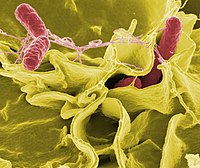
Photo from wikipedia
Background Auxin is critical to plant growth and development, as well as stress responses. Small auxin-up RNA ( SAUR ) is the largest family of early auxin responsive genes in… Click to show full abstract
Background Auxin is critical to plant growth and development, as well as stress responses. Small auxin-up RNA ( SAUR ) is the largest family of early auxin responsive genes in higher plants. However, the function of few SAUR genes is known owing to functional redundancy among the many family members. Results In this study, we conducted a phylogenetic analysis using protein sequences of 795 SAURs from Anthoceros angustus , Marchantia polymorpha , Physcomitrella patens , Selaginella moellendorffii , Ginkgo biloba , Gnetum montanum , Amborella trichopoda , Arabidopsis thaliana , Oryza sativa , Zea mays , Glycine max , Medicago truncatula and Setaria italica . The phylogenetic trees showed that the SAUR proteins could be divided into 10 clades and three subfamilies, and that SAUR proteins of three bryophyte species were only located in subfamily III, which suggested that they may be ancestral. From bryophyta to anthophyta, SAUR family have appeared very large expansion. The number of SAUR gene in Fabaceae species was considerably higher than that in other plants, which may be associated with independent whole genome duplication event in the Fabaceae lineages. The phylogenetic trees also showed that SAUR genes had expanded independently monocotyledons and dicotyledons in angiosperms. Conserved motif and protein structure prediction revealed that SAUR proteins were highly conserved among higher plants, and two leucine residues in motif I were observed in almost all SAUR proteins, which suggests the residues plays a critical role in the stability and function of SAUR proteins. Expression analysis of SAUR genes using publicly available RNA-seq data from rice and soybean indicated functional similarity of members in the same clade, which was also further confirmed by qRT-PCR. Summarization of SAUR functions also showed that SAUR functions were usually consistent within a subclade. Conclusions This study provides insights into the evolution and function of the SAUR gene family from bryophyta to anthophyta, particularly in Fabaceae plants. Future investigation to understand the functions of SAUR family members should employ a clade as the study unit.
Journal Title: BMC Plant Biology
Year Published: 2021
Link to full text (if available)
Share on Social Media: Sign Up to like & get
recommendations!